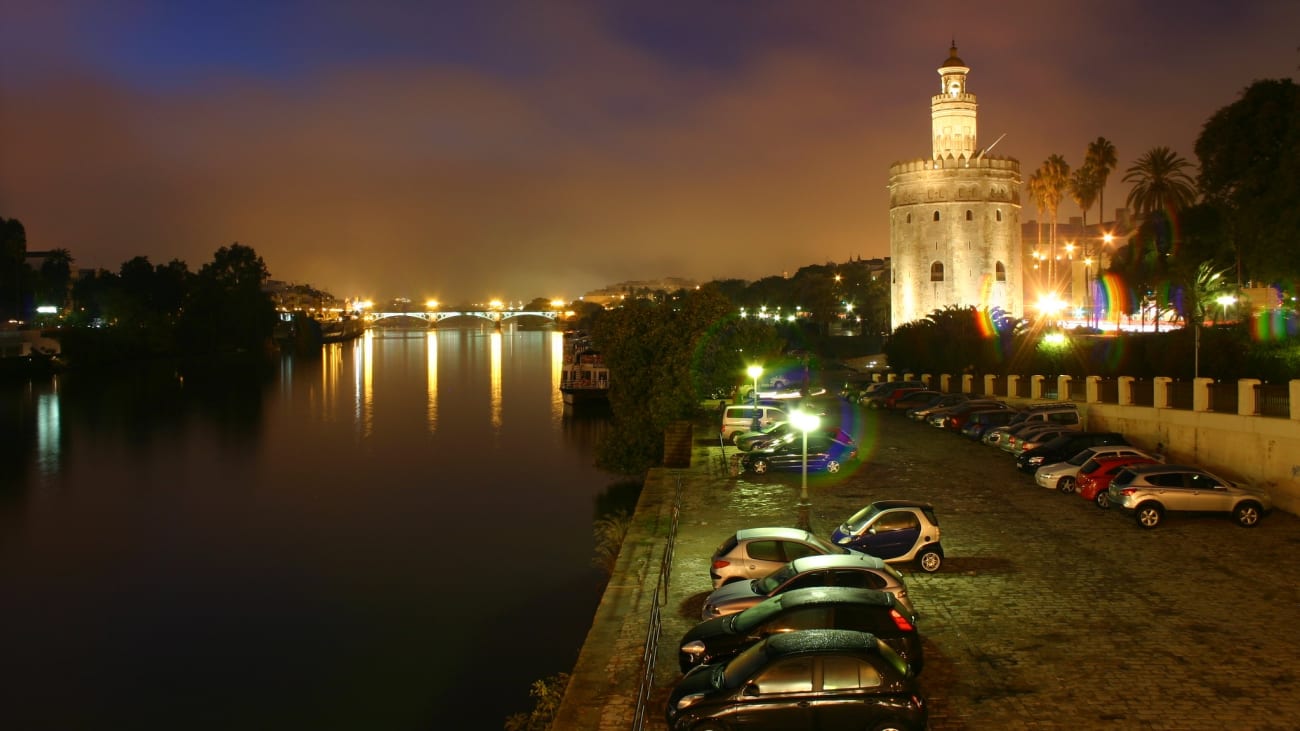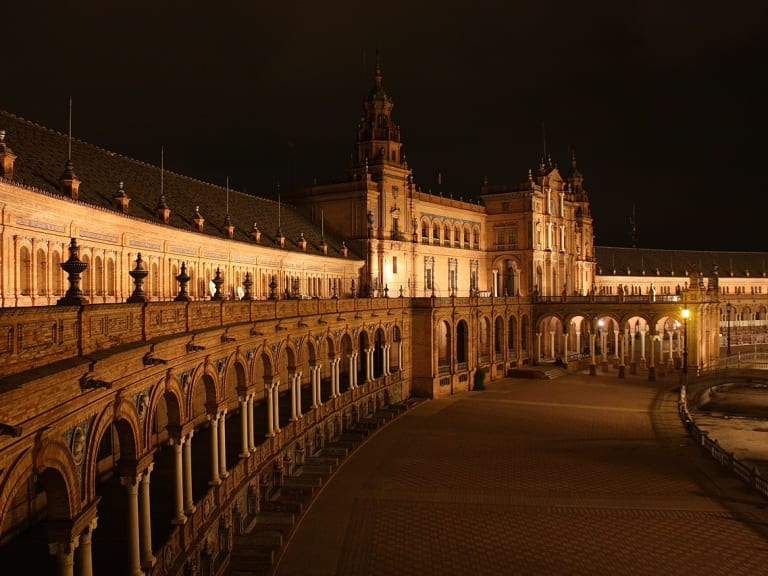6 Best Night Tours in Seville
Strolling through the old town of the Andalusian capital is always a good idea. Especially if you do it after sunset.

Seville, Golden Tower | ©Avinash Bhat
When night falls, Seville becomes a fairytale city. Strolling through its narrow streets is like taking a trip back in time. You'll feel like you're in the Golden Age, when Seville was a hub for trade with America. After sunset, the monuments shine in the darkness and the waters of the Guadalquivir River reflect the light. Can you imagine hearing stories while taking a nighttime stroll through the Andalusian capital? Without a doubt, one of the best things to do in Seville at night is a guided tour, and these are the best ones.
1. Night tour of Seville with flamenco show

We start with a classic route that takes in some monuments and points of interest before ending at a tablao. These routes usually focus on the area around the Palacio de San Telmo and include the following stops:
- Plaza de España, the jewel of Aníbal González. It covers an area of 50,000 square meters and is dominated by a regionalist-style palace. In the lower part, tiles represent the Spanish provinces and a navigable canal runs around the perimeter of the square. This wonderful place has been used as a set for the big and small screen; films ("The Great Dictator," "Lawrence of Arabia," "Star Wars: Attack of the Clones," etc.) and series ("Game of Thrones") have been filmed here.
- Torre del Oro, a watchtower built during the Almohad period. It marked the entrance to Seville's old port.
- María Luisa Park. The city's most beautiful garden is just a stone's throw from Plaza de España and is a true oasis of peace. Inside there are ponds, fountains, monuments and the Archaeological Museum. It was designed by French gardener Jean-Claude Nicolas Forestier, who also designed Monte Gurugú, a miniature replica of the mountain of the same name in Melilla. It is a tribute to those who fell in the Rif War. From the top you can enjoy one of the best views of Seville
- Plaza de América, an elegant space inside the park. A pond with water lilies frames a pavilion from the 1929 Ibero-American Exposition, which now houses the Museum of Popular Arts and Customs.
- Casino de la Exposición, a small palace built by Valencian architect Vicente Traver y Tomás in the Neo-Baroque style. It currently hosts art exhibitions and cultural activities.
As you will have understood, these tours focus on the legacy of the 1929 Ibero-American Exposition, an event that changed the face of Seville. After the tour, the guide will take you to a flamenco tablao where you can enjoy performances by flamenco dancers. These tours usually include a drink and one or more tapas.
- Duration: over 3 hours
- Price: from €50
2. Night tour of Triana

Triana is Seville's most famous and picturesque neighborhood. It is located on the banks of the Guadalquivir River and its history is linked to both the river and maritime exploration.
It was home to a school for sailors that trained crews setting sail for America. For example, the famous Magellan and Elcano circumnavigation of the globe began here.
Triana is many things: the birthplace of flamenco, home to Spain's first aeronautical industry, center of the Inquisition, and, above all, a neighborhood with its own identity.
A nighttime visit will give you the opportunity to see its monuments illuminated by streetlights and, with a little luck, by the glow of the full moon. The routes usually include the following stops:
- Capilla del Carmen, an icon of the neighborhood. It is located next to the Isabel II bridge and is nicknamed "el mechero" (the lighter) because of its resemblance to old flint lighters. The project was designed by Aníbal González, the same architect who designed one of Seville's must-see monuments, Plaza España.
- Castillo de San Jorge, a defensive bastion that became the center of the Inquisition in Seville. Today it houses a museum dedicated to religious repression.
- Patio de Monipodio, a house on the corner of Calle Troya and Calle Betis. Miguel de Cervantes "used" it as the backdrop for his novel "Rinconete y Cortadillo."
- Capilla de los Marineros, the temple that houses the Virgin of Esperanza de Triana. In addition to the figure of Mary, the chapel is known for its richly decorated red pine ceiling
- Cava de los Gitanos, now Calle Pagés del Corro. It was home to a large gypsy community and is considered the birthplace of flamenco in this part of the city.
- Puente de Isabel II, the elegant footbridge built by French engineers Steinacher and Bernadet. It was the first bridge to cross the Guadalquivir River
Triana is beautiful, and when night falls, it takes on a magical quality. Take advantage of the opportunity to listen to the guide's explanations and take some evocative photos. Keep in mind that these tours do not usually include food or drinks. If you stop for a drink, it will be at your own expense.
- Duration: around 2 hours
- Price: between €10 and €5
3. Night tour of the Cathedral

Did you know that Seville's cathedral is the largest Gothic cathedral in the world? It was built in several stages and is a true symbol of the city, along with the Giralda, the adjoining bell tower. If the exterior is already a gem in itself, there is much more to discover inside...
In addition to the tombs of Christopher Columbus and other kings and aristocrats, you will see numerous altars, chapels, and sculptures molded by the best artists of the time. Night tours usually include a walk under the roof. You'll see the cathedral from a bird's eye view and discover the stories of the people who built it.
Keep in mind that the cathedral is very busy and tours tend to sell out quickly. I recommend booking your tickets in advance. For more information, I recommend reading the post on how to visit Seville Cathedral and the Giralda.
- Duration: 1 hour and a half
- Price: around €20
4. Night tour of the Royal Alcázar of Seville

Long before the Reconquista, the Caliph of Cordoba, Abderrahman III, ordered the construction of a fortress on the foundations of a Roman building: thus, the Royal Alcázar of Seville was born.
The building was enlarged and modified by both his successors and the Christian kings, and today it features five different styles: Mudejar, Gothic, Mannerist, Renaissance, and Baroque.
The Royal Alcázar of Seville is the oldest royal residence in Europe still in use. It is located in the heart of the city, a stone's throw from the Palace of San Telmo and the Cathedral of Santa María. Its main attraction is the Palace of Pedro I, a complex of rooms, gardens, and corridors for the exclusive use of the monarch. Other highlights include the Casa de la Contratación, the Cuarto Real Alto (the official residence of the monarchs) and the Gothic Palace, among others.
Night tours are usually dramatized and revolve around the painter Bartolomé Esteban Murillo. He was a master of chiaroscuro and tenebrist techniques, which he learned from Flemish artists, Velázquez, and the Italian Renaissance painters. He lived most of his life in Seville, and the Real Alcázar houses one of his paintings: San Francisco Solano y el toro(Saint Francis Solano and the Bull).
The show begins with the representation of a young Murillo arriving at the Palace of King Don Pedro after being rejected from a ship bound for the Americas. From this point on, the whole story unfolds. Night tours are held on weekends and are for groups of up to 45 people.
- Duration: 1 hour and a half
- Price: around €15
5. Night tour of Santa Cruz

Before the Edict of Granada and the subsequent expulsion of the Sephardic Jews, the Santa Cruz neighborhood was Seville's Jewish quarter. Time seems to have stood still in these streets, and if you visit after sunset, you will enjoy its relaxed atmosphere even more. The night tours will help you discover the most important sights and monuments:
- The Church of Santa María la Blanca, one of the most beautiful in Seville. Although the exterior is rather simple, behind the threshold lies a wonderful interior. Its richly decorated vault is spectacular, as is the figure of Our Lady of the Snows.
- Plaza de Santa Cruz, the square that gives its name to the neighborhood. A synagogue once stood on this very spot.
- Calle del Agua, a street that owes its name to an ancient aqueduct.
- Murillo Gardens. Until 1862, they were part of the Royal Alcázar of Seville, while today they are one of the most evocative corners of the Andalusian capital. You will stroll under orange trees, ficus trees, and magnolias.
- Calle Fabiola and the remains of the old city wall
- Plaza de la Alfalfa, the heart of Roman Seville. Here you will find some of the best tapas bars in the city
More than a big city, this part of Seville is reminiscent of a typical Andalusian village with its narrow streets lined with orange trees.
The guide will tell you stories about the neighborhood and the legend of La Susona, a Jewish woman known for her great beauty. The tours usually start in front of the Casa de la Memoria, a cultural center that hosts flamenco performances and exhibitions (Calle Cuna 6).
- Duration: approximately 2 hours
- Price: around €10
6. Night tour of paranormal Seville

The center of the Andalusian capital is home to the city's main mysteries. In these streets, ghosts and mysteries are more common than you might think, and thanks to these itineraries, you will discover a different side of Seville. The routes stop at all or some of the following attractions:
- Ghost restaurant, Seville's Bermuda Triangle. Electronic devices stop working and objects move around for no apparent reason. The guide will tell you all about the terrifying events that have taken place here.
- Faculty of Fine Arts, the former Casa Profesa de la Compañía de Jesús, located in the heart of the old town. A few years ago, some cleaners realized that something strange was going on here...
- Hospital de las 5 Llagas, the seat of the Andalusian Parliament. The deputies are not the only ones walking its corridors...
- The old Vilima warehouses, an icon of the city that was never the same after a devastating fire. It is located on Calle Lagar, a short distance from the Setas de Sevilla. By the way, from the top you can enjoy one of the best views of the Andalusian capital.
- Cuna maldita(Cursed Cradle), a little bed where you wouldn't leave your child for a minute
- British Institute, the academy in the heart of the Santa Cruz neighborhood. A few years ago, during renovation work, the remains of a young woman were found along with a bronze candelabra.
- Casa de las Sirenas, a romantic mansion in the Alameda de Hércules. A lost soul continues to enjoy its elegant halls.
- Plaza San Leandro, a peaceful urban corner with a fountain known as Pila del Pato
- Casa Fabiola, a 16th-century palace that houses the Bellver Museum, a collection of more than 500 works by different artists. Those who work here often see inexplicable phenomena...
In addition to the explanations of an experienced guide, the tours usually include images and audio recordings made in these same places. This allows you to immerse yourself in the stories and enjoy the tour even more. The tours usually start at a central location such as Plaza de la Encarnación or Plaza del Triunfo.
- Duration: between 1.5 and 2 hours
- Price: around €15
Why is Seville worth visiting at night?

Perhaps it's the reflections on the river or the silhouette of the Giralda illuminated in yellow. One thing is certain: Seville is even more beautiful at night. Its monuments glow in the darkness, creating a romantic scene of rare beauty.
It's also an ideal option if you're visiting the city in summer. During the day, temperatures often reach 40ºC, making walking difficult.
What are the public transportation hours in Seville?

It depends on the day and the means of transport. The Seville Metro is an easy and economical option. You can't go wrong: it has only one line. The price of a single ticket depends on the distance traveled and ranges from €1.35 to €1.80. As for the schedule, it operates as follows:
- 6:30 a.m. to 11:00 p.m. (Monday to Thursday)
- 6:30 a.m. to 2:00 a.m. (Friday and the eve of public holidays)
- 7:30 a.m. to 2:00 a.m**.** (Saturday)
- 7:30 a.m. to 11:00 p.m. (Sunday and public holidays)
Buses in Seville are operated by the TUSSAM company. There are dozens of lines operating at different times. They generally start running around 5:00 a.m. and finish at midnight, although there are exceptions.
I recommend taking a look at the official website. For more information, I recommend reading the post on how to get around Seville.
